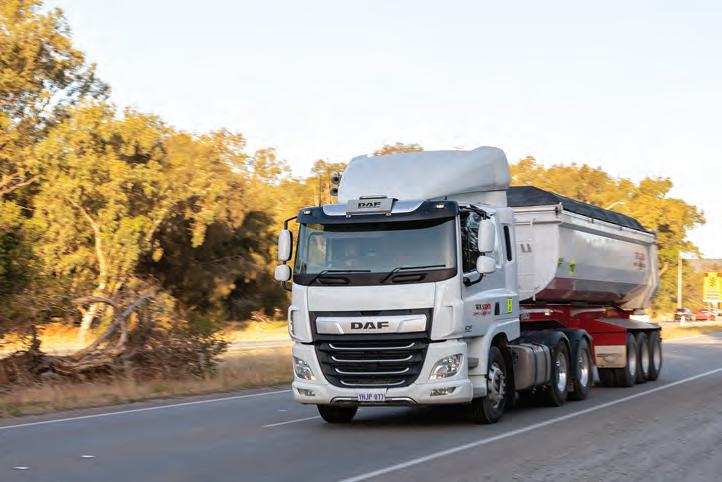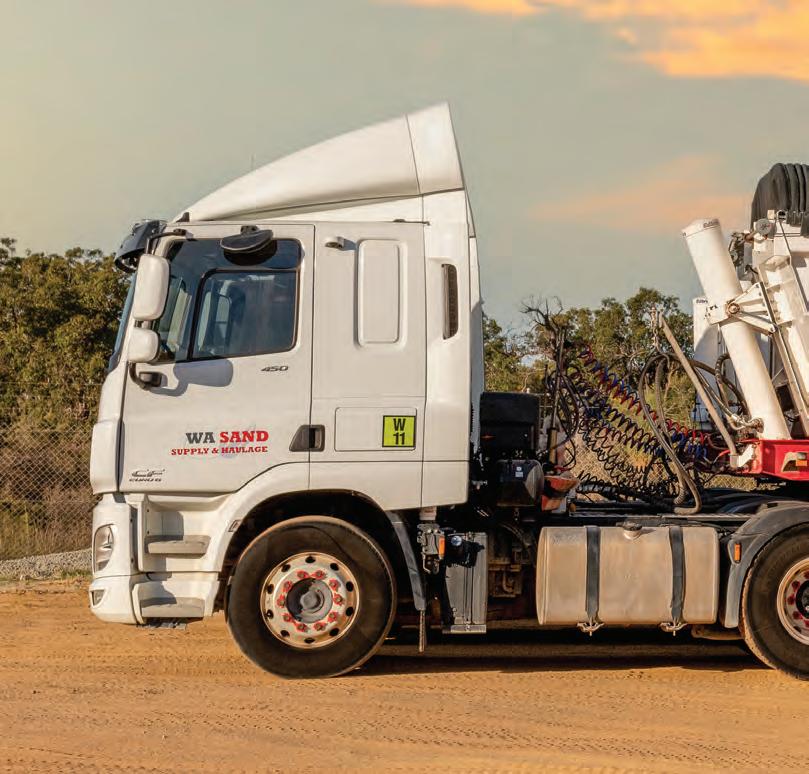
9 minute read
Line in the Sand
New DAF CF 450s lined up in Hazelmere in Perth.
Perth-based transport business, WA Sand Supply & Haulage, is growing rapidly as it diversifies its customer base. With a recent order of Euro 6 DAF CF 450s received late last year, it now boasts the biggest fleet of DAF commercial vehicles in Western Australia.

WA Sand Supply & Haulage services major infrastructure projects in and around metropolitan Perth. Based in Hazelmere, it is conveniently located next to a quarry and only minutes from dealership CJD Trucks Forrestfield. A second-generation truck company whose roots begin in the plateau of Turkey’s Central Anatolia region, the business was founded by Tyson Inceoz, Gorkem Pezik and Tolga Kaya and is now run by Tyson’s son Salih, who goes by Sal. Having worked with trucks from a young age in Aksaray, a two-and-a-half hour drive from the Turkish capital of Ankara, Tyson emigrated to Western Australia in his mid-20s. After trying his hand as a plasterer and then painter he eventually found his way back into the transport industry as a tow truck operator before eventually landing at Holcim where he drove as a subcontractor. At one point he had 15 trucks. In 2012 WA Sand Supply & Haulage was established. The first prime mover purchased was a DAF CF85 460. For the best part of the last ten years the company has been a loyal DAF customer and with good reason. The DAF fleet is now up to 25 units including the new DAF CF 450s, its five latest purchases. Contrary to the esteemed regard now afforded the DAF brand among the team, according to Sal, expectations were not high initially. “When we first bought the DAFs we never had high hopes about it. We were thinking maybe we’ll get a couple of years out of it before getting rid of it,” he recalls. “In just two years all the other branded trucks fell apart and the DAFs kept going strong. We said, maybe we should change to DAF! And ever since then it’s been all about DAF in the metro area. Of course, our expectations were formed without even trying the truck. Within two years all the other truck brands fell apart and the DAFs in that time have not missed a beat.” The original truck is still in use. It was recently sold to one of their contractors with a mammoth 750,000 kms on it. That’s three quarters of a million kilometres in a punishing application of continual starting and stopping as Sal likes to point out. “It’s much harder on the vehicle than highway work,” he says. “Things start going wrong earlier on tipper trucks compared to highway trucks, generally speaking.” The business has 70 prime movers and 100 trailers specialising mainly in end- and side-tippers. Road West is

their primary bin supplier with some GTE and Howard Porter trailers as well. The growing DAF fleet also includes a MX-13 powered Euro 6 rated DAF CF 530. European cabovers are standard across the business. Trucks with bonnets are considered less than convenient for entering restricted work sites. “It’s much better to get in and out of tight spaces,” Sal says. “Sometimes tipper spots are very tight and American truck manoeuvrability is not that good. We find the overall height is also an issue in American trucks. We often need to go under as much as we need to work tight angles. In our industry cabovers are the way to go.” In the metro area the WA Sand Supply & Haulage trucks average 200 kms a day, shuttling, for the main part, on repeat journeys. In regional areas where there are less scheduled pick-ups the trucks are prone to travel 800 kms daily. Improved fuel efficiencies in both scenarios are crucial. “Some jobs are two loads a day but involve a great deal of travel and some jobs are short distances but entail 20 loads a day,” Sal says. “Fuel economy is beautiful. In our industry the average is 47 to 48 litres per 100 kilometres. With the DAFs I’ve seen 41, 42, 43 litres per 100 kilometres. If I have to send another truck brand on the same job as a DAF,
“Some jobs are two loads a day but involve a great deal of travel and some jobs are short distances but entail 20 loads a day,” Sal says. “Fuel economy is beautiful. In our industry the average is 47 to 48 litres per 100 kilometres. With the DAFs I’ve seen 41, 42, 43 litres per 100 kilometres. If I have to send another truck brand on the same job as a DAF, the DAF will definitely burn four or five litres-per-hundred less.”
Sal Inceoz WA Sand Supply & Haulage Services
Sal Inceoz with two of his drivers at the WA Sand Supply & Haulage depot.


the DAF will definitely burn four or five litres-per-hundred less.” On the five new DAF CF 450s, the MX-11 engine is so quiet it has caught out some of the drivers new to it according to Sal. “When you’re driving the revs will be very low so you fail to realise it,” he says. “Some drivers getting into it for the first time have made the mistake of assuming the truck doesn’t have any pulling power because you can’t hear the engine. I say, ‘mate just watch the speedo,’ and they agree that the truck pulls pretty hard but it goes unnoticed given how quiet it is.” The new vehicles, which, in the current environment of supply chain disruptions, took less than four months between order and delivery, have all gone into the metro area on short haul detail limited to carrying 29 tonnes. Aerodynamic and styling refinements to the cab, in visible contrast to its predecessors over the past decade, are noticeable. “It’s a good-looking unit with a real presence on the road. The drivers tell me it’s an absolutely lovely truck to drive,” Sal says. “I haven’t had any issues in finding drivers. I suspect that’s coming from the fact that we’re running brand new gear. I hope people are seeing it on the road and thinking it will be a good idea to work for those guys. I’ve already had several drivers call me up for that very reason.” The interface and the application of drivetrain elements on the 12-speed Euro 6 DAF CF 450 are, according to Sal, worthy of distinction. Reliability always trumps responsiveness for the task he is asking of the vehicles. “The ZF TraXon automated gearbox shifting is very smooth. It never ever makes a mistake, and it always knows which gear to select,” he says. “What I like most about the brand is that they keep it simple. It’s not overly complicated. Even a man who is 60 years old and who has driven American trucks his whole life can jump without fear into a DAF. It’s very user-friendly.” Last year the business found its feet in diversifying its customer portfolio. The decision, which protects it from fluctuations in local and global economies, has brought with it exposure to markets in commercial, rail, roads, imports, exports and iron ore. In Kalgoorlie, WA Sand Supply & Haulage is running triple side tipper sets in the mining industry. Other contracts have been serviced in the Pilbara region. The DAF XF series trucks have also, when required, hauled iron ore on B-doubles in some of the harshest conditions

The DAF CF 450s are carrying loads of 29 tonnes in single trailer applications. One of the new DAFs working on the outskirts of Perth.
going. If that weren’t enough, the daily obligation was a distance of 1400 kilometres with some 160 kilometres consisting of rutted gravel road. “The DAF XF did its job without any issues,” says Sal. “In stark comparison to the other more supposed mining friendly brands.” Upon completion of the job the new assets recently acquired for these obligations have subsequently been redeployed in Perth where commercial and residential construction remain the bread and butter business, augmented periodically by road works such as Kalamunda Road and Great Northern Connect. A land subdivision usually requires 100,000 to 200,000 tonnes of sand depending on the size of the project. On government projects like Perth Stadium, for which WA Sand Supply & Haulage was engaged, it is not uncommon for 2,000,000 tonnes of sand to be shifted from the quarry to site up to a dozen times in a day. In Perth there is a vast network of quarries which mercifully reduces trip times. Again, the DAFs, with a competitive total cost of ownership, are leading the way for a business that can’t afford any downtime as it actively grows its footprint. That kind of consumer confidence is indeed rare. “When I drop it off for a service I request that we pick it up the same night because I know there’s going to be no defects found on that truck and it’s going to be ready to work again first thing in the morning,” Sal says. He’s not scared to answer dread phone calls from drivers either, knowing the call won’t be truck related. “If our whole fleet was DAF I don’t think I would need to wear work boots — no more high vis,” he says. “I could come to work in a suit. You know what I mean? I can sleep comfortably at night because I know my trucks are going to be ready to work first thing in the morning.” It’s been a relatively swift journey to tendering on huge infrastructure projects — Perth Stadium cost around $1.6 billion — for Sal whose introduction to the industry came through his father. At age ten he was washing trucks. That led to a five-year apprenticeship to become a mechanic. A heavy vehicle combination licence and considerable driving followed. “I have grown up around trucks,” he recalls. “I was always helping my old man out on weekends, after school. I was always trying to help lighten the load on him.” Despite overseeing a serious heavy vehicle operation, Sal is still driving, maintaining his equipment and managing the business. “I’m washing trucks on the weekend. It’s a part of my life. I don’t mind being at work every day or being at work on the weekends,” he admits. “I love it. If I don’t love it, I wouldn’t do it.”









